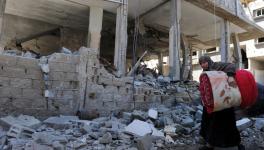Nasty War in Yemen- U.S. Heavily Involved

Photo Credit: Anton_Ivanov / Shutterstock.com
A United Nations Panel of Experts sent its report to the UN Security Council this week. The tenor of the report is bleak. Yemen, say the experts, is ‘in danger of fracturing beyond the point of no return’. Furthermore, the report suggests that despite the almost two years of war, ‘an outright military victory by any one side is no longer a realistic possibility in the near term’. The UN looked at airstrikes by Saudi Arabia’s coalition and found that these are ‘almost certain’ to violate international humanitarian law and that some of the strikes ‘may amount to war crimes’.
In the interests of proportionality, the UN experts say that the Yemeni rebels, who the Saudi coalition have been fighting, are ‘highly likely’ to have violated international humanitarian law with their strikes against civilians areas (markets, hospitals and residential neighborhoods). The details in the report suggest that this verdict – while true – is unbalanced in terms of scale. There is no question that the Saudi coalition has had the ability to commit crimes at a level much higher than the Yemeni rebels. These rebels comprise the Houthis and the forces of former president Ali Abdullah Saleh. Saudi Arabia came to the defense of the ousted president Abdu Rabu Mansur Hadi with the entire weight of its Western-backed air force and army. That it has not been able to stop the ambitions of the Yemeni rebels is significant. The UN experts panel says that the Saudi bombing, ‘while devastating to Yemeni infrastructure and civilians, has failed to dent the political will of the Houthi-Saleh alliance to continue the conflict’.
The UN report is an indictment of this merciless war. It should be read – when it is publically released – alongside the many reports by the UN agencies about the fragile condition of Yemeni society.
Ten days ago, Jamie McGoldrick of the UN’s Office for Coordination of Humanitarian Affairs said that the UN estimates the death toll in this war to be about 10,000 people, with 40,000 people wounded. This is, as the UN accepts, a conservative figure since it is based on numbers gathered from medical facilities. The situation was so dire last August that the International Committee of the Red Cross donated mobile morgue units to local hospitals that could not handle the number of dead bodies that were brought to them.
The UN’s McGoldrick, in these remarks, noted that about ten million Yemenis need ‘urgent assistance to protect their safety, dignity and basic rights’. This is classic UN language for a situation of great urgency. What McGoldrick says is that almost half the population of Yemen is in urgent need. In May of last year, UNICEF noted that 90 per cent of Yemen’s people are in need of humanitarian aid. UNICEF now says that almost half a million children children suffer from Severe Acute Malnutrition – which renders them powerless before the growing threats of diarrhea and pneumonia. Each week, says UNICEF, a thousand Yemeni children die of preventable diseases. These are the children who are in the worst situation. There are also 2.2 million children who suffer from malnutrition (1.1 million adults should be added to this list).
Food prices escalated as a result of the blockade of the country – in some places food costs twice what it did a year ago. When Saudi Arabia closed the Sana’a airport last year, it meant that the UN’s World Food Program could not reach the millions of people who rely upon this aid. The UN’s Emergency Relief Coordinator Stephen O’Brien told the UN Security Council that ‘if there is no immediate action, famine is a now a possible scenario for 2017’.
The West, so sanctimonious about some conflicts, is utterly silent on Yemen. The United Kingdom and the United States continue to resupply Saudi Arabia and its allies with weaponry as they pummel Yemen. Last year, the US Senate limited the sale of military goods to Saudi Arabia. President Donald Trump’s hastily put Saudi Arabia back on its good list. Half a billion dollars worth of observation balloons have been sold to the Kingdom, an indication of what is to come despite Saudi Arabia’ record in the region.
Here is another situation where the ‘international community’ is arming one side in a politically fruitless conflict, while this same ‘international community’ claims to be the arbiter of humanitarianism in the United Nations. The UN has asked for an emergency fund of $2.1 billion. Given the parsimonious contributions to the UN basket for Yemen during this war, it seems unlikely to meet its target. Easier to sell arms than to provide relief.
Al-Qaeda in the Arabian Peninsula.
Last year, stunningly, fighters from al-Qaeda in the Arabian Peninsula (AQAP) and its proxy Ansar al-Sharia joined the Saudi proxies in the battle for the southern Yemeni city of Taiz. Large parts of Southern Yemen, which the Saudi-backed forces see as their zone, are controlled by AQAP. The city of Mukalla, along Yemen’s coastline, is the capital of AQAP’s emirate – both of which wins it allies amongst the Yemenis of the Hadramawt. The AQAP government has been conducting land reforms and has abolished local taxation. Its money comes from piracy and from seizure of bank deposits. Periodic US airstrikes – such as one in March last year that killed fifty AQAP fighters – rattle the confidence of the emirate but do not threaten it. Saudi Arabia’s war has given the AQAP stability. It has provided fighters to the Saudi cause and has therefore insulated itself from bombing by the Saudi aircraft.
So let’s get this straight. The United States and the United Kingdom are arming the Saudis to conduct a war in Yemen. The Saudis, in turn, have begun to rely upon al-Qaeda to conduct the ground war in parts of Yemen. So the West has tacitly allied with al-Qaeda in this conflict.
On January 29, just after US President Trump said that no one from Yemen was allowed into the United States, US troops entered Yemen on a raid against AQAP. The massive US deployment entered the impoverished Yemeni town of Yakla, where they killed dozens of civilians including several children. Amongst these children was eight-year old Nawar al-Awlaqi, whose sixteen-year old brother had been killed in 2011 by a US drone strike authorized by former President Barack Obama. Nawar’s grandfather, a former minister of agriculture in Yemen, said that the bullet from the US soldier struck her ‘in her neck’. She suffered for two hours, he said, before she died.
The Pentagon first said that no civilians had been killed, but then admitted that US troops ‘likely’ killed some civilians. Abdulraouf al-Dhahab, whose house was the target, had often said he had not ties to al-Qaeda. But he was killed. Sixteen civilians, including several children, died in the raid. One US Navy Seal – Ryan Owens – died in the attack.
Neither al-Dhahab nor young Nawar were the targets of the raid. The real target was AQAP leader Qassim al-Rimi, but he was not there. The Pentagon tried to suggest that they were not after him, but merely wanted to seize AQAP computers from the house. That such a massive raid would be conducted to procure intelligence beggars belief.
No wonder that al-Rimi released a caustic statement, saying, ‘The new fool of the White House received a painful slap’. It was a harsh taunt. Al-Rimi probably feels insulated by the needs of Saudi Arabia in its quagmire. AQAP will come in use when its other proxies exhaust themselves.
The government of Yemen, to preserve its dignity, has now said that it does not authorize any further US ground missions. Drones, of course, can continue to fly and target Yemeni nationals.
In a show of force, AQAP rushed to capture three towns – Loder, Shuqra and Ahwa – in the southern province of Abyan. Even as they retreated from the first two, they held the third. One reason that AQAP was able to make this dash is that Yemeni troops loyal to Hadi are exhausted by their fruitless war, and they have not been paid in months. They left their posts unguarded. It is likely, as Yemeni officials say fearfully, that what was experienced in Loder, Shuqra and Ahwa would replicate itself in other towns. Why would unpaid town guards bother to fight back against the highly motivated fighters of AQAP?
The UN envoy – Ismail Ould Cheikh Ahmed – has struggled to restart peace talks. A ceasefire last October was broken within hours by a Saudi airstrike on a funeral hall in Sana’a, which killed hundreds of civilians. Recently Ahmed met with Hadi and then with the Houthi-Saleh government’s Foreign Minister Hisham Sharaf. Ahmed has a thankless job. There is no incentive for either side to take these talks seriously. The Houthi-Saleh armed forces recently fired a scud missile into a military base outside Riyadh (Saudi Arabia). This was remarkable feat, which will give them confidence in their war of attrition against Saudi Arabia. The Hadi bloc meanwhile believes that it has not only the Saudis and other Gulf Arabs, but also the West behind it. Appetite for a ceasefire is low on both ends.
Meanwhile, AQAP makes steady gains and the Yemeni people descend into the nearest thing to hell on earth. Hadramawt, the name for southern Yemen, means ‘death has come’. So it has.
Disclaimer: The views expressed here are the author's personal views, and do not necessarily represent the views of Newsclick.
Get the latest reports & analysis with people's perspective on Protests, movements & deep analytical videos, discussions of the current affairs in your Telegram app. Subscribe to NewsClick's Telegram channel & get Real-Time updates on stories, as they get published on our website.
























